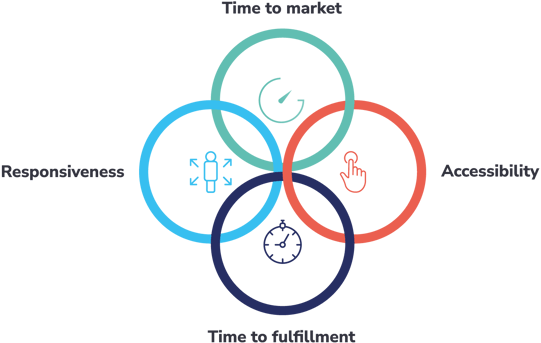Overcoming barriers to a digital-first B2B customer experience
This is an excerpt from a recently published ebook in collaboration with TM Forum “Towards Automation: Improving the B2B Customer Experience”. You can download the full ebook here.
—-
While CSPs compete to develop richer and more innovative product portfolios, they also encounter barriers that prevent them from delivering high-quality customer experiences.
Disconnected systems and data silos elevate the risk of errors during the sales process, resulting in poor delivery.
Lack of automation and over-reliance on manual processes produces inefficiencies throughout the solution-to-cash process.
Outdated sales and order fulfillment journeys fail to meet the digital-first expectations of enterprise B2B customers.
Enterprise B2B customers expect seamless omnichannel self-service as standard, are intolerant of inflexible subscriptions, and want to make changes to them whenever their business requires additional resources, with real-time notifications of order status.
CSPs need a unified platform that connects the end-to-end solution-to-fulfillment process to break free of these systems barriers, and create a smoother customer journey through the entire buying cycle.

Responsiveness
Key Capability for overcoming barriers to CX: High-performing technical architecture for managing complex B2B use cases
Just as in B2C environments, slow processing of key actions within B2B sales journeys creates a poor impression. This is only made more problematic by the fact that B2B propositions are significantly more complex, and the volumes of data points in enterprise orders are vastly more challenging.
Even a single individual enterprise can have requirements that an unprepared provider may require weeks to generate quotes for: multiple locations, thousands of employees, multi-level user permissions and roles.
To take another example: when a CSP integrates a new offer into an existing product, service or plan in order to stay ahead of the competition, the effectiveness of that strategy depends on rolling it out to their entire customer base quickly.
Without a powerful underlying platform, bulk changes at this scale can take weeks or even months. In a hotly contested market, the delay between a sales promise and activation damages the customer experience; B2B buyers expect upgrades to be made available almost in real time.
To satisfy these demands, solution-to-fulfillment platforms need exceptional levels of data processing power. By separating heavy duty data crunching from the standard operations that connect to your CRM platform, workflows can remain fast and efficient.
Time to market
Key capability for overcoming barriers to CX: Flexible product catalog for enabling rapid updates and new solutions
Throughout the contract lifecycle, the promise of creative new offers that meet specific business pain points remains an important element in the B2B customer experience. When innovation stagnates following the initial sale, a buyer’s perception of their provider is negatively impacted.
The challenge for successful CSPs is not merely to devise new portfolio concepts, but to bring these innovations to market quickly.
A flexible product catalog plays a critical role in achieving this, with key capabilities including:
- Permitting product managers to define and roll out new products and services from a single interface without relying on hardcoding and customization support from IT
- Creating static or dynamic bundles that include products, services, subscriptions and third-party offerings
- Making changes and publishing new offers, promotions and bundles to any channel in minutes, rather than in months
Focusing on these product catalog capabilities will deliver a step change speed of bringing innovations to market for your enterprise clients.
Accessibility
Key capability for overcoming barriers to CX: Self-service options that allow B2B customers to use their preferred channel
Giving customers the freedom to make their own purchasing decisions in an intuitive UI across multiple channels has clear positive implications for customer experience.
An effective self-service platform should be able to quickly consume multiple complex product portfolios - especially for businesses that host B2B marketplaces - and support back-end configuration of rules governing which products are presented to whom based on company, role and location, e.g. preventing a Singapore-based customer from seeing connectivity options that are only available in Europe.
With rules in place, all permitted portfolios, products, services and subscriptions are surfaced to the shopfront, allowing customers to independently create product bundles, calculate prices and pay, without having to speak to a representative of their provider.
The modern buyer journey naturally jumps across channels and is rarely continuous or unbroken, with customers liable to abandoning orders, only to return on a different channel. Any future-proof architecture will ensure that all customer touch points, including self-service portals, are accessible through any channel. This may include through a business’ own ERP, e.g. HR ordering new laptops and phones for staff.
Time to fulfillment
Key capability for overcoming barriers to CX: Automate order management to eliminate inaccuracies and delays
Automation is a requirement for any CSP aiming to manage scale and complexity.
By building a powerful business process orchestrator into your architecture, you can create robust automation for end-to-end sales and order management workflows, and overcome the challenges of scale and complexity.
Smooth data flows that disassemble complex orders and send them straight into operational delivery systems, transform the experience for your end customers.
Fast, transparent fulfillment of orders, that aren’t hindered by manual re-entries, can practically eliminate inaccuracies and have a major impact on your NPS scores.
Automations needn’t be limited to initial orders, but be applied to updates and changes for service contracts that are in flight, helping you increase your reputation for responsiveness and further bolster customer loyalty.

Selecting a configure, price, quote (CPQ) platform to underpin your end-to-end solution-to-fulfillment process will directly impact customer experience in multiple ways. For B2B customer relationships it’s important that your platform couples the power to support the complex use cases that are common to this part of the market with the flexibility to respond to customer needs fluidly.